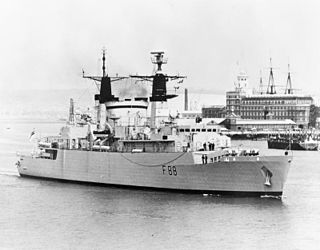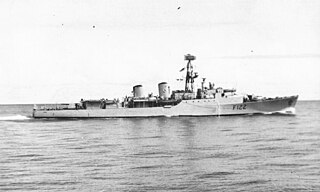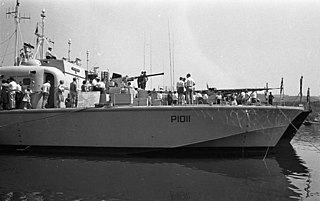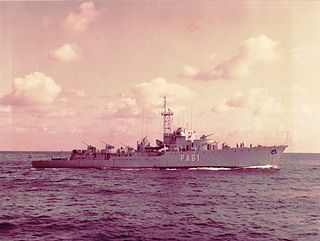
HMAS Attack was the lead ship of the Attack-class patrol boats used by the Royal Australian Navy (RAN). Launched in April 1967 and commissioned in November that year, the ship was largely commercial in design and was used to protect fisheries in Australia's northern waters, and to support the survey ship Moresby. The vessel remained in RAN service until 1985 when it was transferred to the Indonesian Navy and renamed Sikuda.

HMS Broadsword was the lead ship and first Batch 1 unit of the Type 22 frigates of the Royal Navy.

HMS Intrepid (L11) was one of two Fearless-class amphibious warfare ships of the Royal Navy. A landing platform dock (LPD), she served from 1967 until 1999. Based in HM Naval Base, Devonport, Plymouth, Devon and HM Naval Base Portsmouth, she saw service around the world over her 32-year life.
HMS Leeds Castle (P258) was a Castle-class patrol vessel built by Hall, Russell & Company of Aberdeen, Scotland for the Royal Navy. She was launched in October 1980 and commissioned the following August. She was involved in the 1982 Falklands War, operating between the British territories of Ascension Island, South Georgia, and the Falkland Islands as a dispatch vessel commanded by Lieutenant-Commander Colin Hamilton.

HMS Danae was a Leander-class frigate of the Royal Navy. She was, like the rest of the class, named after a figure of mythology. Danae was built by Devonport Dockyard. She was launched on 31 October 1965 and commissioned on 10 October 1967.

HMS Tartar (F133) was a Tribal-class frigate of the Royal Navy (RN). She was named after the Tartar people, most of whom were located in Asia and Eastern Europe. She was sold to the Indonesian Navy in 1984 as KRI Hasanuddin (333).

HMS Gurkha (F122) was a Tribal-class frigate of the Royal Navy. She was named after an ethnic group located in Nepal, and who continue to serve in the British Army. She was sold to the Indonesian Navy in 1984 and renamed KRI Wilhelmus Zakarias Yohannes (332).

HMS Dumbarton Castle (P265) was an offshore patrol vessel of the British Royal Navy. Her main role was the protection of the offshore assets of the United Kingdom, including oil and gas installations and fisheries out to the 200-nautical-mile limit.

USS Samuel N. Moore (DD-747), an Allen M. Sumner-class destroyer, is the only ship of the United States Navy to be named for Samuel N. Moore.

The ships of the F120 Köln class of frigates were the first major warships built in Germany after World War II.

The Sleipner class was a series of corvettes ordered as part of the Royal Norwegian Navy's 1960 fleet plan. It was intended to build five ships of the class, but because of economic problems only two were built; Sleipner and Æger.

The Cyclone-class patrol ships are a class of coastal patrol boats, formerly in service with the United States Navy. Most of these ships, named for weather phenomenae, were launched between 1992 and 1994. The primary mission of these ships is coastal patrol and interdiction surveillance, an important aspect of littoral operations outlined in the Navy's strategy, "Forward...From the Sea." These ships also provided full mission support for U.S. Navy SEALs and other special operations forces. Several ships of the class were transferred to the U.S. Coast Guard (USCG) for a time and then later returned.
HMS Berkeley was a Hunt-class mine countermeasures vessel of the British Royal Navy. She was sold to the Hellenic Navy in 2001 and was commissioned as HS Kallisto. On 27 October 2020, she was cut in two in a collision with a container ship.

HMS Falmouth was a Rothesay-class, or "Improved Type 12", anti-submarine frigate built for the Royal Navy during the 1950s. She took part in the Third Cod War in 1976, ramming the Icelandic gunboat V/s Týr. Both ships suffered extensive damage.

The Brave-class fast patrol boats were a class of two gas turbine motor torpedo boats (MTBs) that were the last of their type for the Royal Navy (RN) Coastal Forces division. They formed the basis for a series of simpler boats which were widely built for export.

The Commandant Rivière class was a class of frigates built for the French Navy in the late 1950s and early 1960s. Labeled "aviso-escorteur", they were designed to perform the role of overseas patrol in peacetime and anti-submarine escort in wartime. This vessel class is named after the French Navy officer Henri Rivière (1827–1883).

USS Kansas City (AOR-3) was the third of the Wichita-class replenishment oilers. She was the second ship to be named for the city of Kansas City, Missouri.

The Sparviero class, also known as the Nibbio class, are small hydrofoil missile boats capable of traveling at speeds of 46 knots. They were designed for and formerly used by the Italian Navy. The Japanese 1-go-class missile boat is an updated version formerly used by the Japan Maritime Self-Defense Force (JMSDF).

HSwMS Älvsborg (M02) was a minelayer in the Swedish Navy, launched on 11 November 1969. She had one sister ship, HSwMS Visborg. She belonged to the 1st Submarine Flotilla and served as leader of the division. In 1997, Älvsborg was sold to Chile and was renamed Almirante José Toribio Merino Castro. She was taken out of service on 15 January 2015.

The Atrevida class was a class of six corvettes built for the Spanish Navy in the 1950s.

















